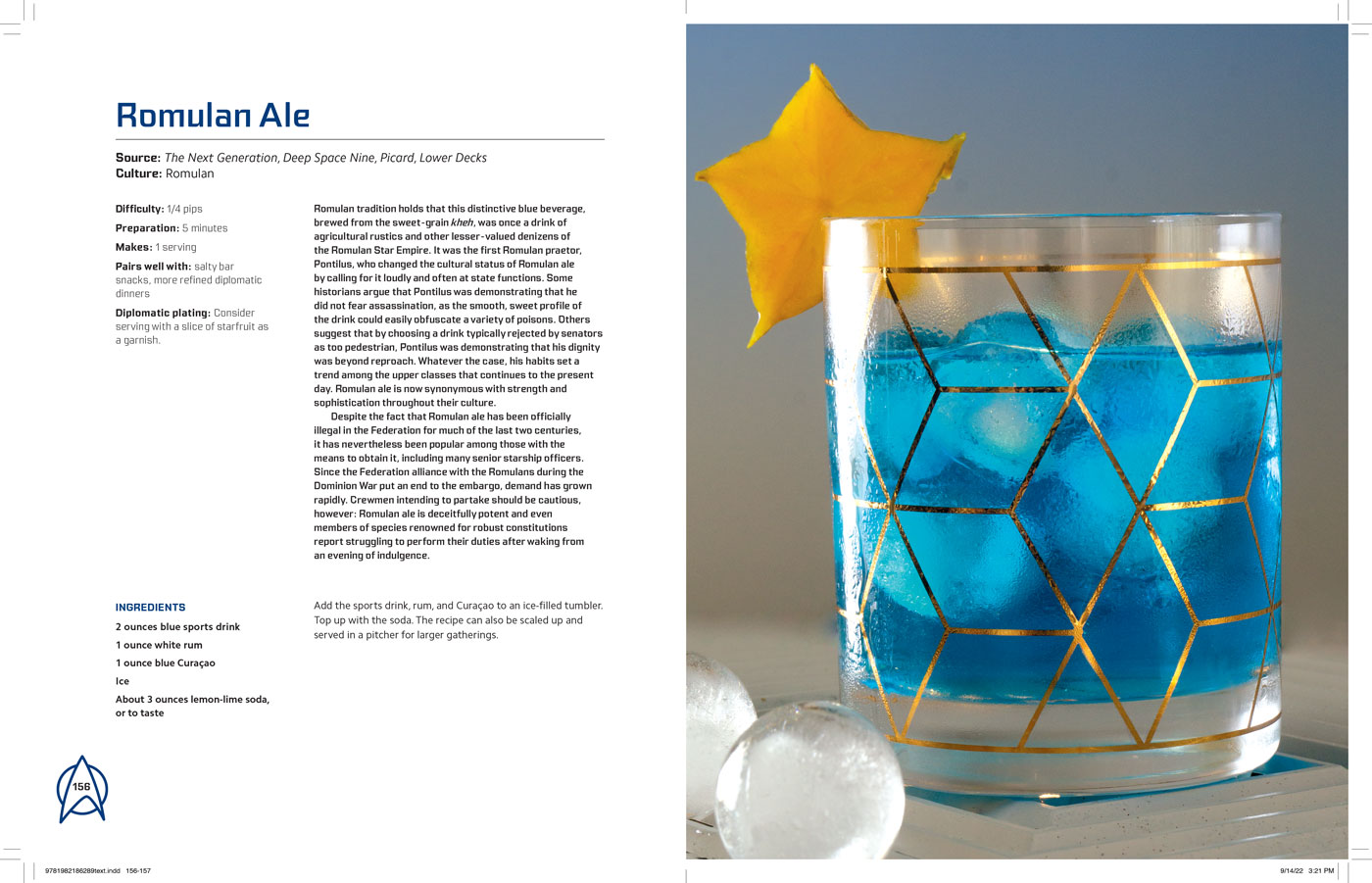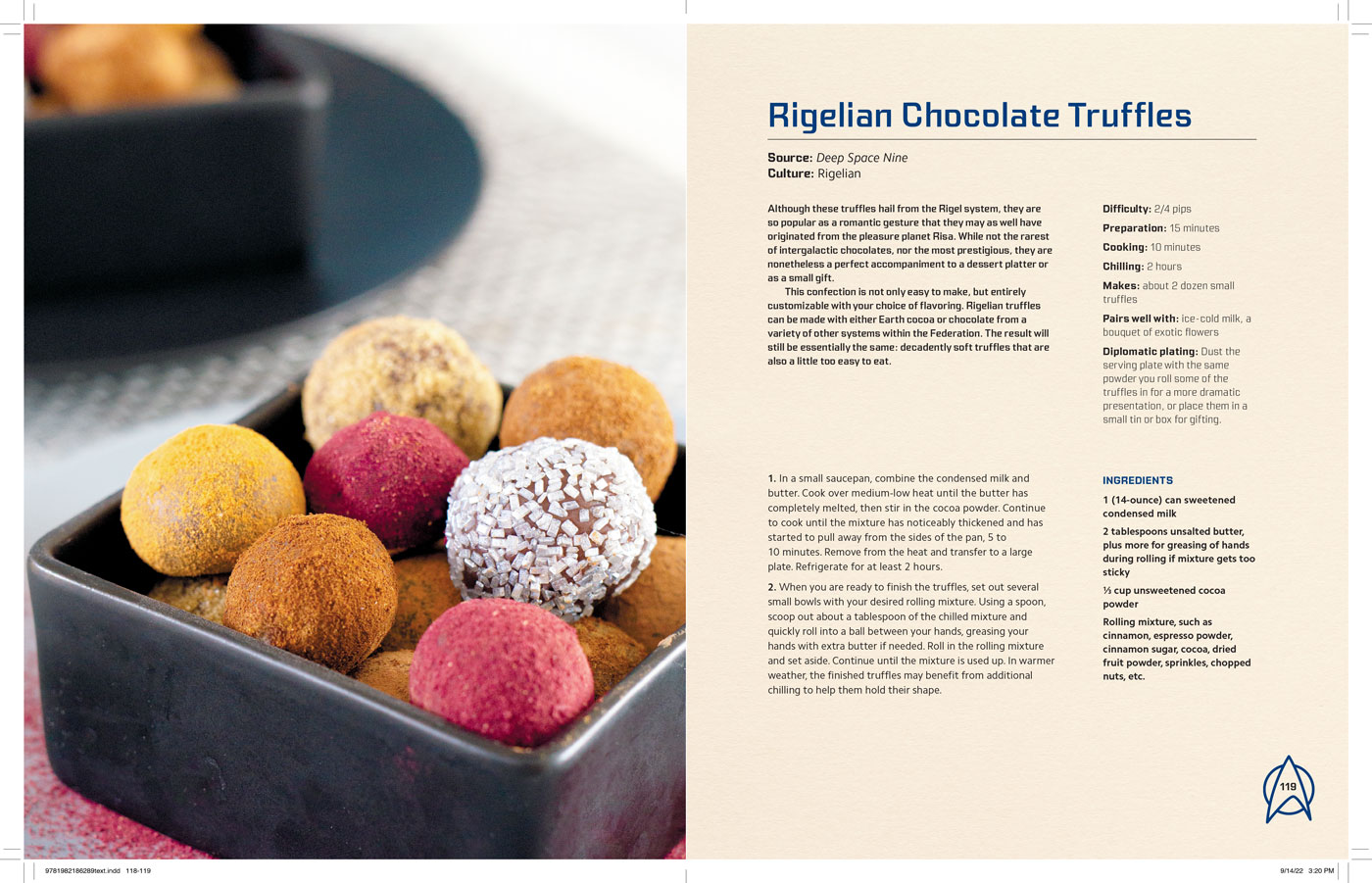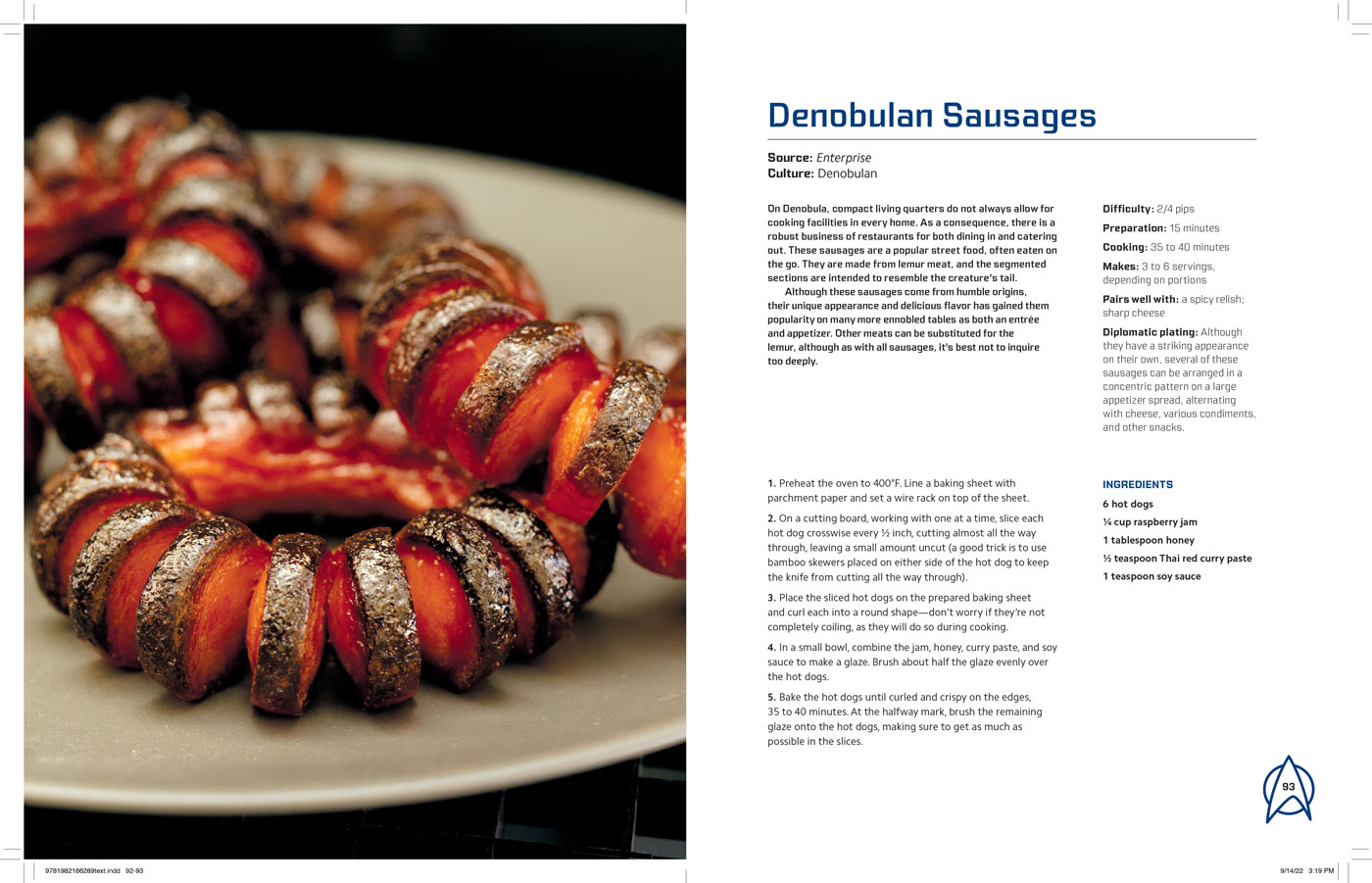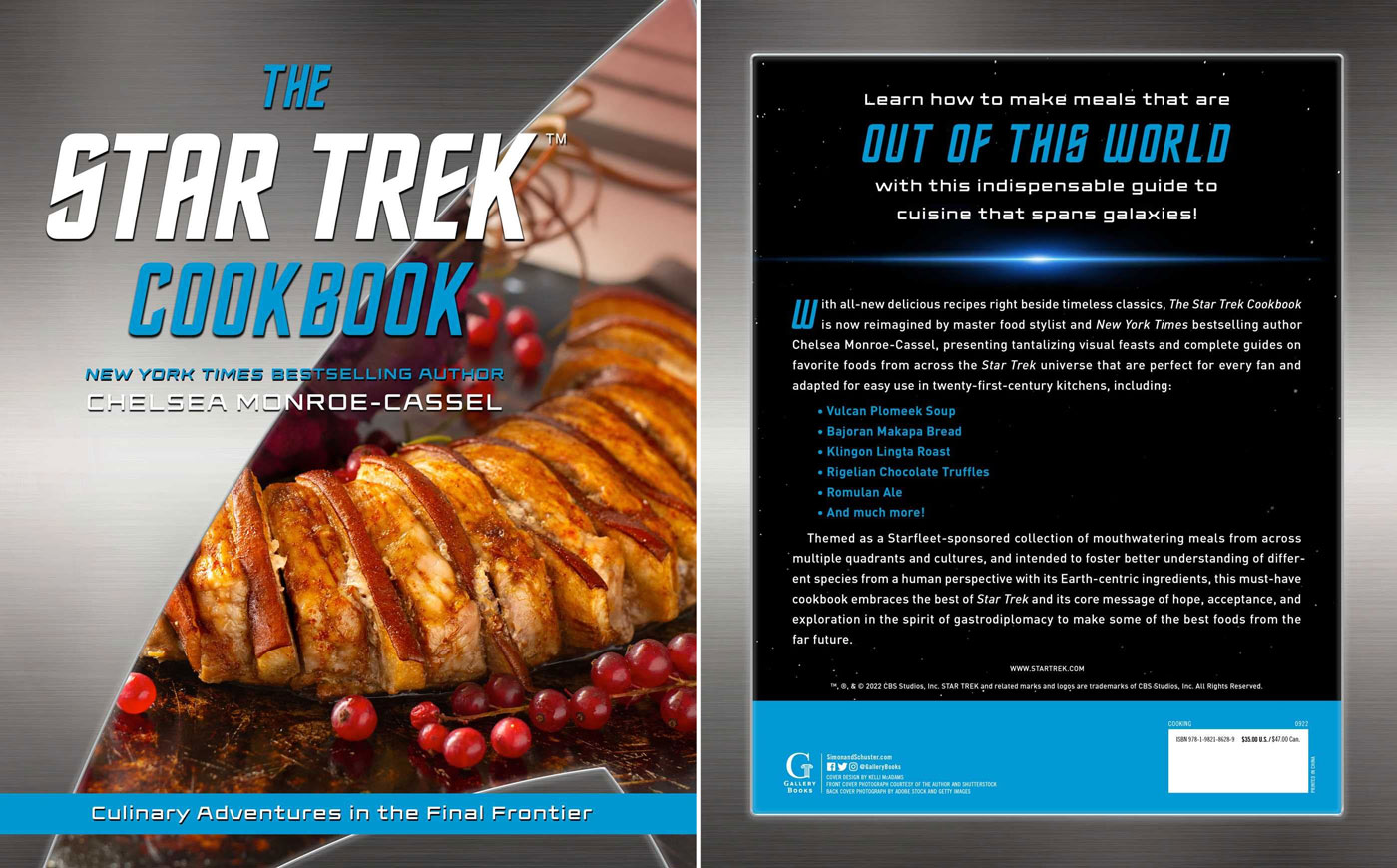More than twenty years after the first Star Trek Cookbook found its way home from the Delta Quadrant, Chelsea Monroe-Cassel returns to the galley with a brand-new take on food from the final frontier — and we had the opportunity to chat with the author ahead of this week’s brand new edition of The Star Trek Cookbook.
Learn how to make meals that are out of this world with this indispensable guide to the food of the stars! Perfect for every fan, this updated edition of The Star Trek Cookbook from the New York Times bestselling author comes with brand-new and delicious recipes, tantalizing visuals, and easy-to-follow instructions and advice to make the best foods from the future.
With all-new recipes right beside timeless classics, food stylist and New York Times bestselling author Chelsea Monroe-Cassel’s reimagining of The Star Trek Cookbook presents a visual feast along with complete guides on favorite foods from across Star Trek, adapted for easy use in 21st-century kitchens.
Themed as a Starfleet-sponsored collection of recipes from across multiple quadrants and cultures, and intended to foster better understanding of different species from a human perspective with its Earth-centric ingredients, this must-have cookbook embraces the best of Star Trek and its core message of hope, acceptance, and exploration in the spirit of gastrodiplomacy.
TREKCORE: What was your origin story with Star Trek? How did you become a fan?
CHELSEA MONROE-CASSEL: I grew up watching Star Trek: The Next Generation with my dad, and I love it. I love all of it. I think it’s amazing. I think it’s very cool because it’s such a hopeful view of the future and I love a dystopian story as much as the next person, but when it increasingly feels like maybe we’re living in a dystopia, it’s nice to have your escapism promise you something better!
TREKCORE: This is now the second Star Trek cookbook. The first Star Trek Cookbook, which was released in 1999 and is presented as a cookbook written by Neelix, is still in print today. How do you approach this version of the cookbook to provide something new to fans?
MONROE-CASSEL: There’s definitely room for new take on the idea of a Star Trek cookbook. I think that there’s a lot to celebrate about the Neelix cookbook. So many people love it. As you say, for the past 20 years, that’s been THE Star Trek Cookbook. That’s fabulous! It was really, I think, in many ways ahead of its time in terms of fandom cookbooks. It feels like there’s one for every TV show, but in 1999, that was pretty much it.
That said, I feel like it can’t quite decide what it is. You’ve got some recipes from the actors, some from the characters, and a lot of behind the scenes stuff, which is amazing. I loved reading through all of that especially. At the end of the day, it’s got good recipes, which is what counts.
I think from what I’ve read, a lot of people keep coming back to those recipes. I obviously want to be clear that this new Star Trek Cookbook is in no way meant to replace that one. I think there’s definitely room on a shelf for both of them, if you’re so inclined, or for just one or the other. I didn’t want to copy it. It is its own thing.
I wanted to give a fresh take on it. I didn’t actually really closely read any of the recipes themselves but I did read a lot of the behind the scenes stuff, just for any insights as to how to make my own recipes better, especially with like the Romulan Ale. Tell me anything that is whatsoever useful about Romulan Ale behind the scenes. Just give me a starting point.

With this and with all cookbooks I do, I always start with arguably a ludicrous number of lists. I make crazy amounts of lists. The first one is everything that I know should go into the book, and that fans will expect to see. The gagh, the Plomeek soup, things like that. The next list is maybe things that sound cool. Just reading through the names on Memory Alpha.
A third list could be things I saw on Pinterest that look like space food, and do they match up well with anything that’s on one of the other lists — or do I have to make something new that is still in keeping with the world?
I always try to keep my recipe collections as canon as possible. For example, the Uttaberry Cruffins in the cookbook: cruffins are not canon yet, but Uttaberries are. It’s a little bit of wiggle room, but it’s still, I think hopefully at heart, really rooted in the world of Star Trek.
TREKCORE: How do you approach turning Star Trek food, which was just meant to look good on screen, into an edible recipe that people will enjoy? For example, how do you give fans a recipe that allows them an enjoyable experience of eating gagh without them needing live serpent worms?
MONROE-CASSEL: You hit on exactly the thing with the Klingon food in particular, where if you take something like the Rokeg Blood Pie; I think in “A Matter of Honor” is a bunch of cut up beets with butter scotch pudding and like cranberry juice or something over top, and you’re just like, “Oh yes, not with a 10 foot pole am I going near that as an edible dish.”
The cookbook has a version of the Rokeg Blood Pie that is edible, but still incredibly gruesome looking. My mother stopped by the day that I was making it and she was just absolutely horrified. She normally likes to try what I’m working on, but not this one!
One of my personal rules is that the food has to not only be edible, but arguably taste good. Even when you’re dealing with a lot of alien cultures, it still has to be food. It still has to be edible and it still arguably has to be good food.
It’s all about finding the balance between how it looks, how it tastes, the ingredients that go into it, while still making it approachable to make for most people. I don’t have crazy culinary training and I think that that weirdly works to my advantage in some way, because I’m not going to put anything in the book that most people can’t tackle if they wanted.
TREKCORE: The book is presented as a Starfleet Academy text book about the foods of other worlds. How did you approach creating what feels very much like an in-universe book, but balancing that with you also want this to be a cookbook that people use to make recipes?
MONROE-CASSEL: It’s very funny because as you say, it’s a balance in between getting it to feel in-world, but also be practical. I really wanted it to be not just the Federation, but to embrace that hopeful feeling that’s so central to Star Trek and to see if I could do that with food.
As you say, it’s pitched as “understand and experience other cultures through food.” It’s just the other cultures are Andorians and Romulans and what have you.

TREKCORE: Were there any dishes that you really wanted to include that you never figured out a way of fitting into the book?
MONROE-CASSEL: Yes. The ones that got away! Jumja sticks are on that short list. I made them once and they were perfect. The perfect shape, great texture, amazing flavor, and I did not take notes, and I could never do it again. It makes me so mad to this day. I’m hoping maybe at some point I can tackle that again and a couple other ones for the blog.
Another one was the Samarian Sunset cocktail. I desperately wanted to include something, at least as an homage to that and the way it changes color when you tap the glass. But you can do a cocktail that changes color with fizzy powder and stuff, but it’s over the course of 15 minutes of sitting on the counter and it’s not exactly showy.
The ones that got away still get me. I still think about them. That, combined with the fact that nobody gave me a sneak peek at Strange New Worlds so I didn’t know that Pike cooks in every single episode. There’s some really good looking food in that captain’s quarter.
TREKCORE: Plenty of opportunity then for Volume 2.
MONROE-CASSEL: I’m going to make the argument! A couple more seasons under our belt and see what else he makes.
TREKCORE: Are there any dishes that you are particularly proud of?
MONROE-CASSEL: For comedic value, I really like the Spatchcocked Tribble because the Short Trek “The Trouble with Edward” that gives us the origin story of the tribbles is one of my favorite little slivers of Star Trek, everything. I just think it’s hysterical.
I got a kick out of that one. For that one, I think we zoomed in on the photo, but I made a mock up of a replicator to photograph it in the Original Series era. I did one for Discovery too, but I think they never quite worked for the photography because you needed to pull back too far from the food in order to see it was a replicator. But we now have replicators in the house, so that’s great!
TREKCORE: What recipe would you recommend for the beginner chef? And what about the Star Trek fan who considers themselves as skilled as Neelix in the kitchen?
MONROE-CASSEL: For the most part, all the recipes have a difficulty rating. I think it should be pretty easy for people to pick something that’s within their skill range. There aren’t that many that are crazy difficult.
I think the Uttaberry Cruffins are probably one of the hardest recipes, because you make a little quick jam and you make a rough puff pastry and it’s a little finicky and then you do the weird little shapes. That one I think is pretty good for a high challenge.
The soups are very easy for somebody just tackling it for the first time. Those are really good. I think the Denobulan Sausage is very showy for how relatively easy it is. That’s one of my other pretty easy picks.

TREKCORE: Having just spent a period of time immersed in both Star Trek and food, what’s your reflection on the role of food in Star Trek?
MONROE-CASSEL: Most people, many people, they say, “Oh, a Star Trek cookbook. Why do you need that? They have replicators. You just push the button that’s your cookbook.” I argue that a world with replicators is not a world without cooking.
Even if you loved a dish, every time you replicated it, it would be the same dish exactly and there would be no artistry to it, no nuance. Whereas if you replicate the ingredients and then you assemble them, then you’ve got something interesting. You’ve got a little variation. If you feel like a little more red pepper that day, you can just throw that on top.
I think they touch on this in at least one or two episodes, I think, of TNG, where Riker’s making that really terrible looking omelet using Owon eggs. It looks so bad, but over and over again, we see food in Star Trek as this integral part of it. Whether it’s the replicators in the mess halls and people coming together to eat, or food in the captain’s quarters as an honored guest.
Also off world, every time you send a landing party down, for better or worse, they’re eating the local flora fauna food, various repercussions. It’s comedy too. Lower Decks touches on that a lot. They’re constantly in the mess hall fighting with the replicator if it doesn’t recognize them, or the replicators shooting food out when they malfunction. It’s amazing. It’s so quietly a part of Star Trek, as it’s a part of the real world, our everyday lives.
I think one of the cool things about fictional food is that it takes something that is essential for us to live and it removes it a step or two from what is normal and what is just rote. We all need to eat to live, but isn’t it great if we can eat for fun too, and get a little bit closer to the places and people that we really admire through food?
That’s what I try to do — open that doorway a little bit for people.
![]()
The new 2022 edition of The Star Trek Cookbook is in stores now.

